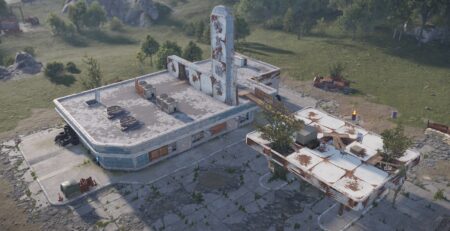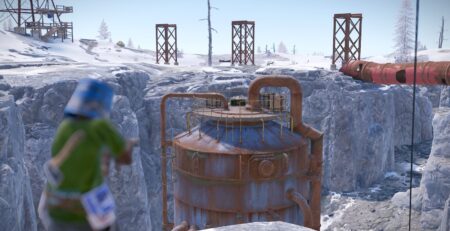RUST Beginner Tips – Ultimate Starter Guide for Rust Players
Your Comprehensive Starter Guide to the Essential Rust Beginner Tips
Embarking on the gritty and relentless journey that Rust offers is an experience that hinges between thrilling survival and unforgiving challenges. As a newcomer, the harsh realities of Rust’s world may seem overwhelming, yet with the right guidance, the path to becoming a seasoned survivor is a reasonable goal. This starter guide for Rust serves as your companion through the early stages of Rust, offering a reservoir of essential tips to navigate the difficulties of the game. These tips are in no specific order, but just to offer a rich library of vastly beneficial information to a new player of the game.
Table of Contents
- Selecting the Ideal Server
- Resource Gathering
- Crafting the Essentials
- Building a Base
- Food, Water, and Health
- Sleeping Bag Placement
- Combat & Self-Defense
- Research & Crafting
- Team Up
- Maintain a Low Profile
- Base Upkeep
- Resource Gathering Efficiency
- Exploration & Monuments
- Utilizing Stashes
- Monument Puzzles
- Radiation Protection
- Animal Hunting
- Invest in a Furnace
- Craft Medical Supplies
- Base Expansion
- Explore the Area
- Stay Informed
- Frequently Asked Questions (FAQ)
- Conclusion
Selecting the Ideal Server
Your entry into Rust begins with choosing a server—a decision that could shape your initial experience. Rust offers a variety of servers, each with its own set of rules and communities:
- Official Servers: These servers are managed by Facepunch Studios, the developers of Rust. They often host a large population of players, which could be a challenging playground for a newbie due to the presence of seasoned players.
- Community Servers: Managed by the community, these servers often harbor a friendlier atmosphere with more active admins. They might have unique rules or mods that cater to a more relaxed or structured gameplay.
- Modded Servers: These servers are modified to offer a different gameplay experience. They may have increased resource-gathering rates, custom plugins, or other alterations that change the game dynamics.
For a beginner-friendly experience, consider starting on a community or modded server with active admins and a welcoming atmosphere. Look for tags like “beginner”, “easy”, or “noob” when browsing the server list. Additionally, consider how long ago their wipe was from seeing the “… days old” within the browser. Joining a freshly wiped server may likely be overwhelming as those are generally when a server is its highest population.

Resource Gathering
The backbone of survival in Rust revolves around gathering essential resources. Here are the primary resources you’ll need initially:
- Wood: Your primary building material. Obtain wood by hitting trees with a rock or, later, a hatchet.
- Stone: Used for crafting and upgrading your base to a sturdier material. Gather stones from rock nodes scattered across the map.
- Metal Ore and Sulfur Ore: Essential for crafting advanced items. Find these in rock nodes as well, but they require a furnace to smelt into usable materials.
- Cloth: Used to craft bandages, sleeping bags, and clothing. Always gather the hemp plants on the ground when you see them to quickly craft cloth-based items.
Efficiency is key—aim for the red X on trees and the shining spots on rock nodes to gather resources much faster. Check your surroundings from time to time.
Crafting the Essentials
Crafting is your gateway to better survival tools, shelter, and defense mechanisms. Initially:
- Craft a defensive tool such as Spear which is only 300 wood or alternatively a bow with arrows.
- Craft a Stone Hatchet and a Stone Pickaxe for faster resource gathering.
- A Sleeping Bag is crucial for setting a respawn point, make sure to craft and place one early on using cloth.
- Craft a Building Plan and Hammer to start constructing your shelter.
You can also browse crafting calculator sites to get the exact requirement needed for any item as well as more information about items, costs, amounts, etc, from sites like Rustlabs

Building a Base
Your base is your sanctuary, where you’ll store resources, respawn upon death, and take a breather from Rust’s harsh environment.
- Location: Living further away from higher-tier monuments is ideal when starting to avoid high-traffic areas. Also, live close to resources if possible.
- Design: Start with a simple design like a 1×1 or 2×1 with an airlock to prevent raiders from easily accessing your base. Check out Sigbog on Youtube which showcases many interesting base-building tips to save on space and more!
- Upgrade: Upgrade your base to stone as soon as possible to enhance its durability against raids.

Food, Water, and Health
Keeping your metabolism in check is crucial in Rust and your overall health as you’ll start to die slowly if you starve/dehydrate:
- Hunting Animals: Using a bow, spear, or other weapon hunt for animals and then use a hatchet, or bone knife to harvest them for raw meat, animal fat, hide.
- Cooking: Just after hunting you will want to cook the raw meat in a timely manner since it will spoil. Craft a campfire and place the raw meat to quickly cook it.
- Water: Find fresh water sources in rivers or collect it from water catchers. You can store this in water bottles or drink from rivers directly when looking down.
- Radiation: Be cautious around larger monuments as they include radiated areas; you’ll need proper clothing or radiation pills to explore these regions safely.
Sleeping Bag Placement
Place a sleeping bag inside your base for a reliable respawn point. Additionally, place extra sleeping bags hidden in nearby bushes or other concealed spots as backup respawn points in case your base is being camped by hostile players.
Combat & Self-Defense
In Rust, threats lurk around every corner. Equip yourself with basic weapons like a spear or a bow initially, and as you progress, aim to acquire firearms to better defend yourself. Understanding the basics of combat, such as aiming, taking cover, and choosing your battles wisely, will significantly improve your chances of survival.
Research & Crafting
Scrap is a valuable resource used for researching items at a Research Table or unlocking items within the Workbench, allowing you to craft them later. Collect items and scrap to gradually from roadside barrels and boxes around the map to build up your arsenal of craftable items. Remember, some items can only be acquired through looting and then researching.
Team Up
Rust can be brutally challenging for solo players. If possible, team up with friends or make new allies in the game. Working together allows for resource sharing, better defense against threats, and a more enjoyable experience as you learn the ropes of Rust. If they’re more experienced than you, you may learn some handy Rust beginner tips from them as well!
Maintain a Low Profile
Especially as a newcomer, drawing attention to yourself can lead to unwanted confrontations. Avoid engaging with well-equipped players, keep your base discreet, and be cautious when venturing into high-traffic areas. As you gain experience and resources, you can take on greater challenges and engage more with the community.
Base Upkeep
Your base will decay over time if not maintained. To prevent this, ensure you have a Tool Cupboard filled with necessary resources like wood, stone, and metal fragments for upkeep. Regularly check your Tool Cupboard to replenish the resources and keep your base standing strong.
Alternatively, there are tips you can utilize to vastly optimize your actual upkeep cost by utilizing mechanics in the game. We recommend watching this video by Sigbog!
Resource Gathering Efficiency
Maximize your resource gathering by aiming at the red X on trees and the sparkling spots on nodes when harvesting. This yields more resources per hit. Upgrading to better tools like a metal hatchet or pickaxe will further boost your gathering efficiency.
Exploration & Monuments
Rust’s vast landscape is dotted with monuments, each containing valuable loot and resources. Familiarize yourself with the different monuments, their layouts, and the potential risks involved, such as radiation and hostile NPCs. Exploring monuments can yield crucial items like weapons, tools, and scrap, which is essential for researching and crafting advanced items. We have multiple guides on the Rust monuments to browse easily as well.
Utilizing Stashes
Small Stashes can be a lifesaver for hiding valuable items. They can be buried underground and are invisible to other players unless they are very close. Use them to hide crucial items outside your base, so in case of a raid, not all is lost.
Monument Puzzles
Some monuments have puzzle rooms that require keycards and fuses to access. These puzzles lead to valuable loot, but be sure to learn the requirements and risks involved before attempting them. Studying guides or videos on how to solve these puzzles can be very beneficial.
Radiation Protection
Many valuable looting areas in Rust are radioactive. Ensure you have adequate radiation protection before venturing into these zones. Acquire clothing items like Hazmat suits or pieces of clothing with radiation resistance to shield yourself from radiation poisoning. As featured by Sigbog, hazmat suits are much weaker against NPC damage so we recommend wearing alternative clothing sets for your best fighting chance!
Precautions: Carry lots of water, medical syringes, or food in high-radiated locations.
- No Radiation Protection Required:
- Abandoned Cabins
- Cargo Ship (before exit warning)
- Dome (Outside)
- Harbor
- Junkyard
- Mining Outpost
- Abandoned Supermarket
- Oxum’s Gas Station
- Lighthouse
- Ferry Terminal
- Quarry (Any type)
- Low Radiation Protection (10):
- Dome (Inside)
- Satellite Dish Array
- Sewer Branch
- Gear: A full set of burlap is sufficient.
- Medium Radiation Protection (20):
- Airfield
- Train Yard
- Water Treatment Plant
- Gear: Full set of burlap, wooden armor, and a bandana or a single snow jacket.
- High Radiation Protection (30 or a Radiation Suit):
- Launch Site (additional protection needed for main building)
- Military Tunnels
- Power Plant
- Nuclear Missile Silo
- Gear: Radiation suit or Snow jacket with other gear.
- Extreme Radiation:
- Launch Site Main Building
- Cargo Ship (after exit warning)
- Nuclear Site Steam Generators
Animal Hunting
Animals are a great source of food, leather, and other materials. Use ranged weapons or melee weapons to hunt them. Be cautious when hunting aggressive animals like bears or wolves, as they can deal significant damage. More information on animals can be found in our Animals in Rust Guide.
Invest in a Furnace
A furnace is crucial for smelting ores into usable materials. Build a furnace early on to start processing metal ores and sulfur ores. These materials are essential for crafting better tools, weapons, and base upgrades.
Craft Medical Supplies
Keeping a stock of medical supplies is vital. Craft bandages and medical syringes to heal up during or after encounters. Also, always have a few on your hotbar for quick access in emergencies.
Base Expansion
As you accumulate more resources and gain confidence, consider expanding your base to include additional storage, crafting stations, and defensive structures. A well-fortified and organized base will serve as a strong foundation for your survival and progression in the game.
Stay Informed
The Rust community is active and constantly evolving with new updates and strategies. Stay informed by joining forums, reading the Rust patch notes, watching other Rust beginner tips videos, and engaging with other players to learn the latest tips and tricks that will help you survive in Rust.
Frequently Asked Questions (FAQ)
What is the first thing to craft in Rust?
The first thing you should focus on crafting in Rust is a stone hatchet or a stone pickaxe, which will significantly improve your resource-gathering efficiency compared to using a rock. Before crafting these, you might need to gather some basic materials using a rock. Following that, crafting a simple spear or bow for self-defense and a building plan for base construction should be your priority.
Can you play Rust solo?
Yes, you can play Rust solo, although it can be quite challenging due to the potential threat posed by groups of players. It’s advisable to join low-population servers or those labeled as “solo” or “solo/duo” to have a more balanced experience. It may also be beneficial to choose servers with active admins to prevent bullying or griefing from larger groups.
What is the best way to get a start in Rust?
The best way to get a start in Rust is by:
- Choosing a beginner-friendly server with a lower population.
- Gathering essentials like wood, stone, and cloth.
- Crafting basic tools like a stone hatchet and stone pickaxe.
- Building a simple base to secure your items.
- Exploring cautiously while gathering more resources.
- Making allies if possible.
Conclusion
Starting your survival journey in Rust can be a daunting yet very fun experience. This starter guide for Rust provides a solid foundation for new players to stand the best chance possible when first trying out the game, or trying to improve your general playstyle. By following these beginner tips, exploring the environment, engaging with the community, and continuously learning, you’ll improve your skills, make memorable experiences, and truly enjoy what Rust has to offer.







